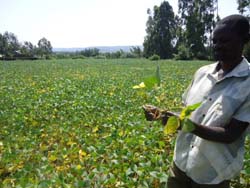Outreach activities continue to test new soyabean varieties, input combinations and cropping arrangements that promote BNF. During the 2012 long rains in west Kenya (March to July), two new soyabean varieties from SeedCo were compared to SB 19 (the current industry standard). SB 19 was also evaluated with and without addition of zinc in an effort to further improve the Sympal fertilizer blend as well as in combination with two new cereal crops, dwarf white sorghum (SC Sila) and IR maize (WS303). The 41 trials were farmer installed and managed, and data collected by N2Africa Master Farmers trained in previous seasons. Each management was established on 45 m2 (444,444 plants per ha) and received Sympal fertilizer (0-23-16 w/S, Mg and Ca) at 125 kg-1. Inoculated treatments received BIOFIX inoculant containing Bradyrhizobium japonicum USDA 110. Cereals received 33 kg N per ha as urea topdressing in split application. Nodule observations were recorded at mid-bloom based on a 0-5 ranking system. Root nodulation responded strongly to inoculation with 55% more nodules, 111% greater frequency of crown nodulation, and 30% increased red interior pigmentation. There was a massive variation in yield between sites ranging from 0.13 to 2.80 t per ha in soyabean monoculture. Average inoculated SB19 yields were 1.12 t per ha, but lower than the past long rains growing season (-12%), probably due to a three week delay in the onset of the rains and a short late-season drought. SC Saga yield responded significantly to inoculation with BIOFIX (+16%). The mean yield of SB19 was greater with the addition of Zn in the Sympal fertilizer blend (+5%), but the response was not statistically significant due to the variability in response.
An economic analysis was conducted based upon production costs, yield and commodity prices, Costs included seed, inoculant, Sympal and urea fertilizers, labor requirement and wages, cleaning and bagging. Production costs ranged between $288 and $382 per ha for non-inoculated Saga soyabean monocrop and the MBILI intercrop, respectively. Net returns ranged between $326 per ha for non-inoculated Saga and $549 for MBILI, although large differences in yield between sites implies that also net returns greatly varied between sites. These returns do not include return on household labor (about $113 to $128 per ha). The favourable return to MBILI intercropping is largely due to the very high price of maize caused by the emergence of Maize Lethal Necrosis Virus ($0.46 per kg). Benefit to cost ratios varied between 1.5 for soyabean-sorghum intercropping (where sorghum was often consumed by birds) and 2.5 for inoculated Squire soyabean (offering a net return $467 per ha).
These results point to several important findings. Even during a season with unreliable rainfall, soyabean production was profitable when net benefits were averaged across sites. Clearly, inoculation of soyabean with BIOFIX containing USDA 110 is a crucial practice and offers the greatest partial return on investment. This improvement was realized among 71% of the fields. Fortification of Sympal fertilizer blend with 0.1% Zn bears no additional cost to farmers and results in yield improvement at 71% of the sites, though further research is needed to better understand on which type of soils Zn additions are most likely to results in a yield response. Our search for cropping options for soyabean continues. The past several seasons, intercropping management has focused upon better performance of soyabeans as an understorey intercrop of maize. Simply substituting soyabeans for beans in farmer’s traditional practice is a poor option as insufficient light results in low yield and poor quality soyabeans. Alternative row arrangements, such as strip cropping or MBILI offer some improvement, but after three years there is little evidence of adoption by farmers. Finally, these findings illustrate the value of engaging N2Africa Master Farmers in the process of refining the use of BNF technologies among small-scale farmers in west Kenya (see photo).
 |
This former tobacco grower in Migori, west Kenya, has shifted to soyabean production using the production package offered by N2Africa (photo credit Moses Chamwada) |
Article prepared by Paul L. Woomer, Kenya Country Mentor
